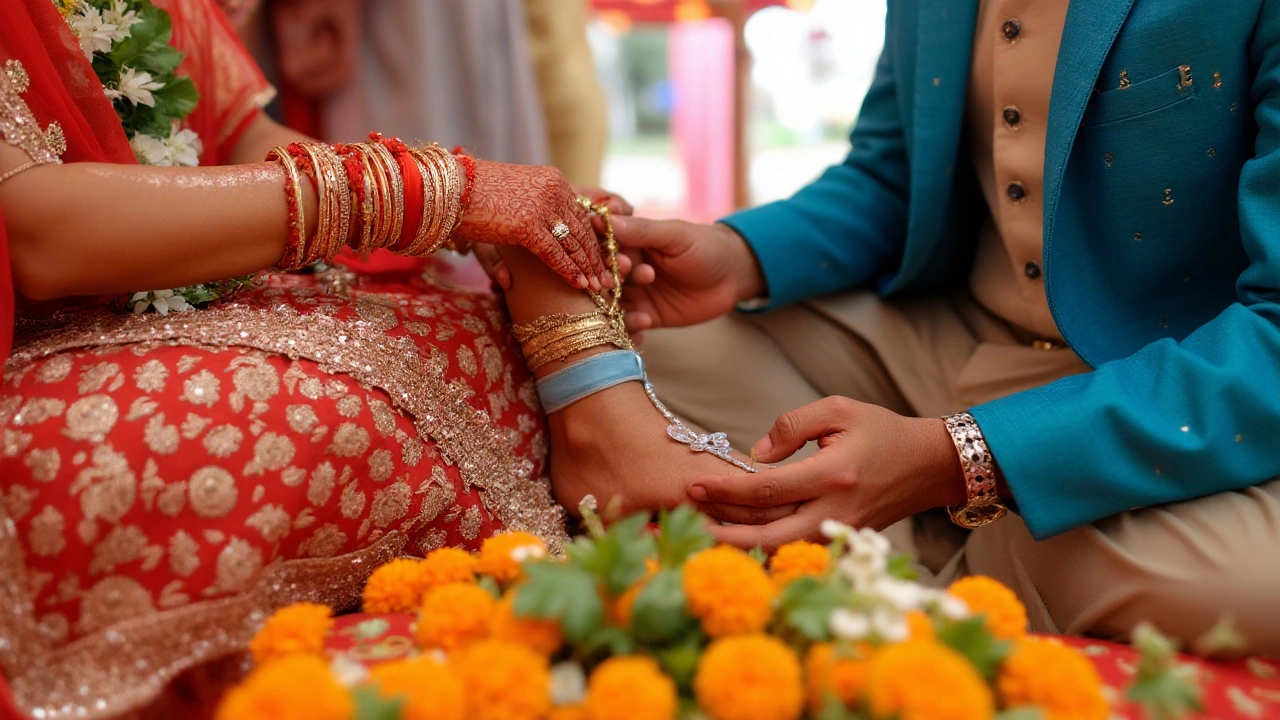
In the intricate tapestry of wedding traditions, the blue garter holds a subtle yet poignant role. This delicate piece of bridal attire is not just an accessory but a symbol cycled from ancient sayings to modern celebrations. The phrase 'something old, something new, something borrowed, something blue' often completes itself with the inclusion of a lucky sixpence, but it’s the blue garter that predominantly graces weddings, carrying a whisper of history and romance.
Delving into its origins, a blue garter’s presence at weddings transcends mere fashion. It embodies themes of purity and fidelity, echoing customs that may seem as old as time. Yet, it has evolved in fascinating ways, intertwining with today's wedding practices, including those related to the groom. A seemingly simple choice, incorporating a blue garter into your nuptials can bridge ages of tradition with your own unique style, perhaps influencing your groom's attire in surprising ways.
- The Symbolism of the Blue Garter
- Historical Origins and Evolution
- The Blue Garter's Connection to the Groom
- Modern Interpretations and Adaptations
- Choosing a Garter: Tips and Styles
- Incorporating Tradition into a Personal Wedding
The Symbolism of the Blue Garter
The tradition of the blue garter at weddings is steeped in history and symbolism, wherein the color blue represents purity, love, and fidelity. These qualities are undeniably cherished in the context of marriage, anchoring couples in a foundation of commitment. Knowledge of where such traditions originate typically bestows an additional layer of appreciation, uniting couples in a continuum of cultural heritage. Within those four iconic elements – something old, something new, something borrowed, and something blue – the blue garter often plays its vivid part, quietly infused with meaning that spans generations.
Historically, wearing or incorporating the color blue at weddings can be traced back to ancient Roman times. Then, blue was associated explicitly with the Roman goddess of marriage, Juno, and was considered to signify constancy. In the Middle Ages, blue was also a popular color for bridal gowns. It was the primary color to symbolize purity before the trend shifted to the white we know today. Yet, the symbolic value of the blue garter remains intrinsically linked to these ancient beliefs, perpetuating the idea of an enduring bond. This begs the thought: how this delicate accessory wields such lasting impact by being imbued with a spectrum of virtues akin to the sky's own hues, inspiring timeless faith.
Susan Waggoner, a renowned author on wedding traditions, wrote, "The customs we observe carry sentiments of continuity and a shared understanding across cultures, remarkable in their ability to unite through collective memory".
The blue garter also encapsulates a nod to a touch of playfulness and anticipation for the future. It is a blend of conservational ethos with contemporary zest, striking a balance between what has been and what is yet to come. This juxtaposition can also be reflected in material choices today for garters, ranging from delicate satin adorned with lace to more modern, minimalistic designs that challenge traditional aesthetics while holding respect for them. When chosen carefully, this tiny garment not only reflects the bride's uniqueness but also creates a narrative that resonates with personal values. In wearing a blue garter, both an homage to what was and an embrace of what will be intertwine in the most charming expression of wedding day sentimentality.
Historical Origins and Evolution
The tradition of the blue garter finds its roots smeared across centuries of folklore and symbolism. This seemingly simple piece of bridal attire has wafted through history, layered with meaning and cultural significance. Originating in the medieval period, the act of tossing the garter was synonymous with the disbanding of the bride’s purity, symbolized by the removal of her clothing to ensure fertility. However, not all traditions were maintained for their initial reasons. As society evolved, so did the meanings, adapting to new contexts while retaining a mysterious allure.
One of the oldest references to the power of blue garters can be connected to the adage 'something old, something new, something borrowed, something blue.' This saying originated from an old English rhyme, suggesting the inclusion of blue as a symbol of fidelity and love, potent emotions married to the idea of marriage itself. Interestingly, in many European cultures, blue has consistently been associated with purity—an association that was later fully embraced by wedding customs.
Tracing the journey through the Victorian era, the tradition of the garter became more refined and less about fertility, turning into a cherished keepsake for brides. During this time, the garter began to embody more than just customs, shifting as a signifier of intimacy and love sealed by the union. Rituals changed, with fewer raucous spectacles during receptions, and instead, more heartfelt exchanges between newlyweds.
Amidst this historical context, the symbolism expanded. By the 19th century, the bride's garter was often decorated with blue ribbons, capturing the essence of fidelity. This change also saw the gradual involvement of the groom, albeit subtly, as he was traditionally the performer of the garter toss – a playful tradition granting the groom an active role in revealing the garter and gently tossing it over his shoulder. A Victorian belief professed that untying the knot of the garter would also untie the magical bonds, unknowingly initiating new trends where, instead of being primarily symbolic, the blue garter began to touch fashion realms.
Tales from Nobility and Beyond
The famous Order of the Garter, England's highest chivalric order, is said to have ties to this custom. According to folklore, King Edward III began the Order after picking up a garter dropped by a noblewoman and tying it to his own leg while exclaiming, “Honi soit qui mal y pense,” which translates to “Shame on him who thinks ill of it.” This quote still adorns the Order’s insignia today. Such stories show how deeply embedded the idea of a garter is, not only among the common populace but also within noble circles as an emblem of personal honor intertwined with unity.
In modern times, the use of the wedding blue garter persists, albeit with new adaptations. The main fabrics and trimmings have transformed, often matching contemporary bridal styles, and the groom's attire sometimes features subtle nods to its color theme, showcasing the seamless integration of tradition with personalized touches. In this evolution, the old one-size-fits solution has expanded into an array of designs, allowing brides more freedom to choose a garter that resonates with them personally, mixing age-old beliefs with modern aesthetics.
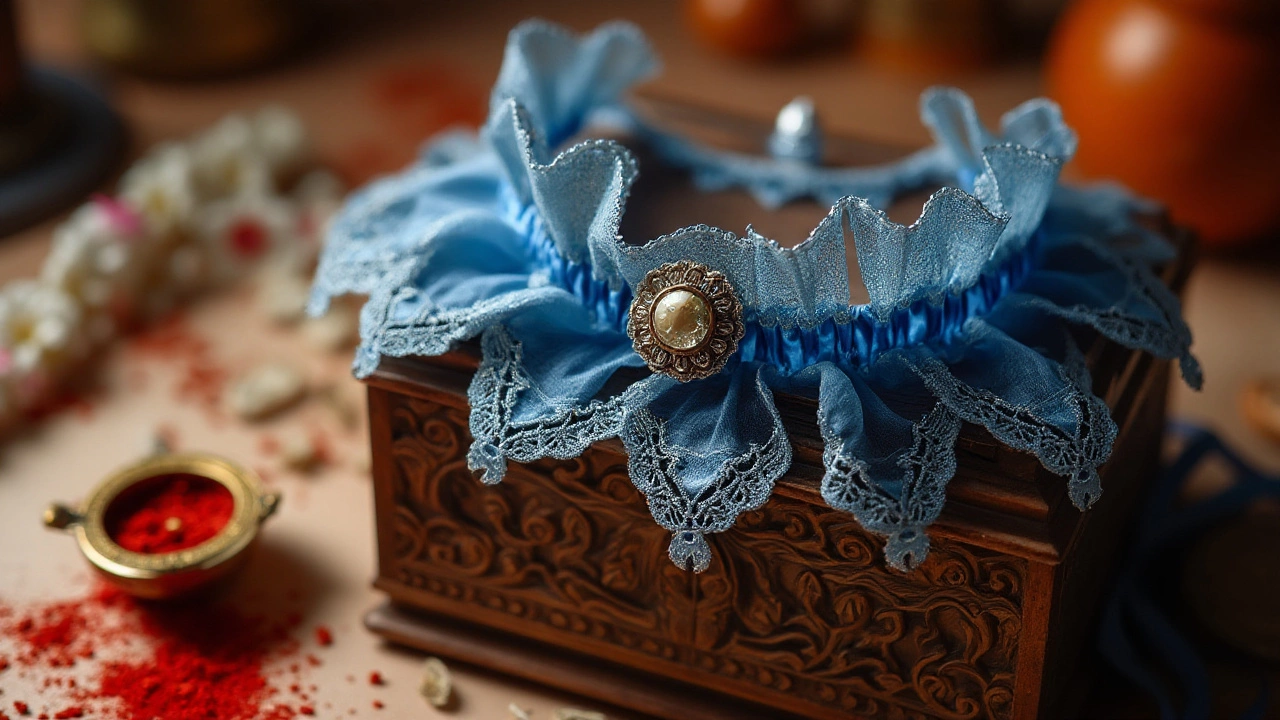
The Blue Garter's Connection to the Groom
At first glance, the blue garter might seem like a decoration solely aligned with the bride's attire. However, its significance reverberates throughout various aspects of the wedding ceremony, touching upon traditions that deeply connect it to the groom as well. In many cultures, the removal and tossing of the garter is a counterpart to the bouquet toss, a light-hearted ritual that brings grooms to the spotlight momentarily. This act dates back centuries, originally symbolizing the groom's right and responsibility as a husband. The garter toss was once a signal of consummation and was believed to bring good luck and prosperity to whomever caught it, often resulting in a playful scramble among guests.
Today, this tradition often takes a whimsical twist. As the groom retrieves the garter, it symbolizes not just traditions of old, but a moment of fun that reminds everyone of the interplay between wedding customs and personal flair. Often set to music, the garter toss can bring humor and excitement to the reception, while allowing the groom to get involved in a tradition that complements the bouquet toss for the ladies. For the groom, engaging in this ritual can enhance his special day, fostering a sense of connection to age-old traditions. Yet, the act is not just about formality—it's about identity and style. Many grooms take this opportunity to express creativity, whether through playful banter, personalized music selections, or synchronization with the wedding's overarching theme and tone.
The relationship between the blue garter and the groom doesn't end at the toss. There’s a growing trend for grooms to match their attire subtly with the bride’s garter. This might involve a hint of blue in a tie, pocket square, or cufflinks, adding a layer of cohesion to the couple's wedding look. This nod to the garter can add a cohesive touch to the wedding ensemble, harmonizing with the bride’s outfit in a way that's visually appealing and symbolically rich. Grooms increasingly partake in this tradition by participating actively in choosing or even purchasing special garter designs that align with their wedding vision. This aspect of planning can itself be a meaningful journey, deepening the personal connection between the bride and groom as they discuss and maybe even collaboratively decide upon the garter that best represents them.
In this modern age, traditions are not boundaries but invitations to inventiveness and personalization. Some couples opt for theme-related costumes or handmade garters that exemplify their shared interests or hobbies, which the groom enthusiastically celebrates during the reception. As the dynamics of weddings broaden to sponsor a diverse range of expressive customs, the connection between the blue garter and the groom continues to evolve. With creativity and a personal touch, new traditions form, marrying the heritage of the past with the vision of today, one blue garter and one thoughtful groom at a time.
Modern Interpretations and Adaptations
As times change, so do traditions, and the beloved blue garter is no exception. Brides today often turn to contemporary expressions of this time-honored symbol, blending its historical significance with personal flair. What once might have been a simple element of the bride's trousseau can now take many forms, each reflecting the distinct personality of the couple. Some brides choose to incorporate other elements into their attire or the wedding's theme as a nod to the tradition. Consider a bride opting for a blue ribbon intertwined within her bouquet or blue embroidered linings in her gown, keeping the essence of the custom alive while reimagining its presentation.
Another modern twist is the color palette expansion that includes seafoam and teal. These hues add a fresh aesthetic appeal, especially in beach or destination weddings. Personalized options have gained immense popularity, with brides selecting garters that feature initials, important dates, or charms that hold particular significance. This personalization transforms the garter into a cherished keepsake. Moreover, non-traditional materials such as lace, silk, or even eco-friendly fabrics provide the versatility to match any wedding style.
In our visually driven digital age, the garter has also become a playful photo opportunity. Capturing moments like the garter toss, an adaptation of older customs designed to bless the marriage, adds a lively and entertaining element to wedding receptions. Some couples even choose to have two garters — one for the toss and one to keep — ensuring the tradition respects both formality and fun. According to renowned wedding planner Emily Post, “A wedding garter is more than an accessory; it's a story thread weaving the past, present, and future of a couple's journey."
The groom and groomsmen have also embraced this concept with playful socks or pocket squares in shades of blue, harmonizing with the bride's garter for a coordinated look. This expansion of the tradition helps celebrate unity, often becoming a special hidden connection between the couple shared through little bursts of blue dispersed throughout.
For those who value historical authenticity, collectible and vintage garters offer a connection to the past. Brides might seek garters from specific eras, reflecting styles from different generations, thereby adding an element of timeless elegance to their ensemble. And if the bride is inclined towards the whimsical, a superhero or sports team-themed garter makes a quirky and personal statement, bridging modern pop culture with matrimonial heritage.
While looking forward and embracing modern spins, couples are also increasingly rediscovering old customs from other cultures, merging these with the blue garter tradition for a multicultural touch. This often reflects the unique journey and diverse roots of global families today. Whether you adapt or hold steadfast to the original color and form, the blue garter allure in weddings remains, proving its cultural resilience and adaptability across generations.
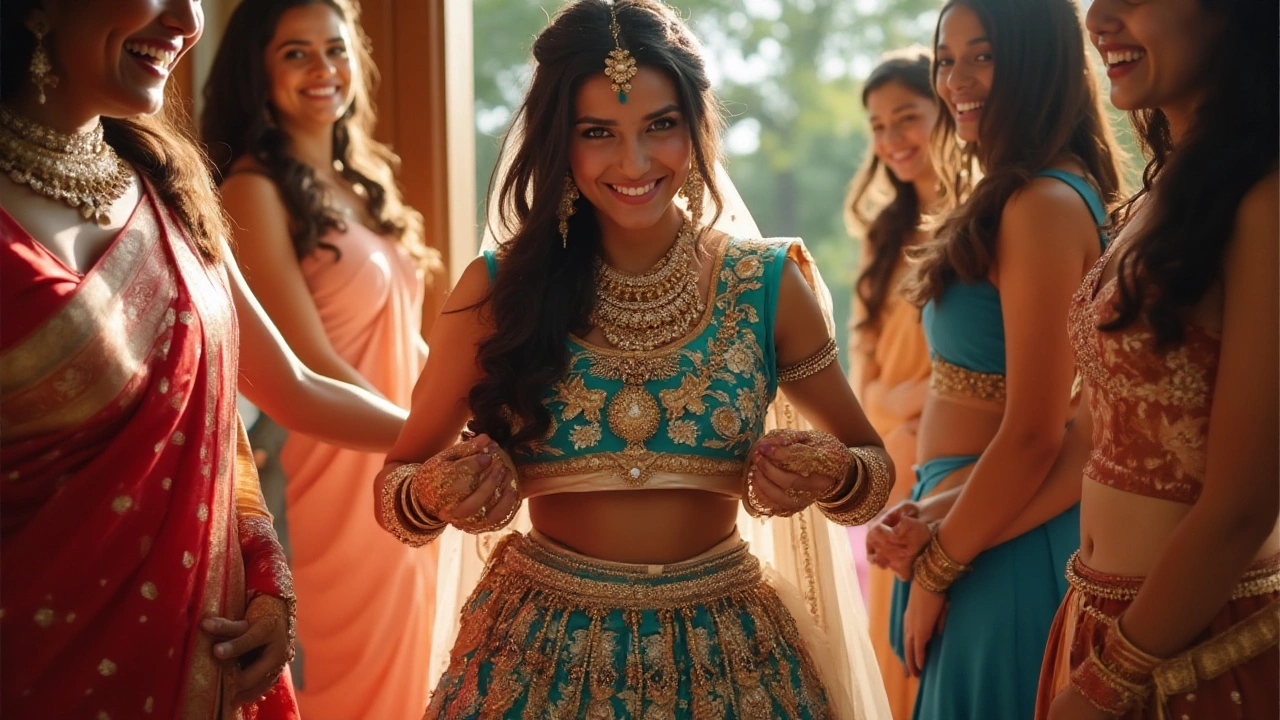
Choosing a Garter: Tips and Styles
The journey of picking out a blue garter is as intimate and personal as selecting the wedding dress itself. This small accessory, while sometimes overshadowed by more prominent wedding elements, can carry enormous sentimental value and tradition. There is no one-size-fits-all when it comes to this delicate piece, and options abound in terms of fabric, design, and hue. Traditionally, the garter is worn on the right leg, just above the knee, although some newer practices allow for more personalized placements.
When it comes to style, lace is a timeless choice, offering a vintage look that harks back to eras past. Satin, on the other hand, lends a more modern sheen and can be matched with the fabric of the bridal gown. Incorporating intricate beading, small gemstones, or embroidery can add a personalized flair, potentially reflecting the bride's personality or the wedding theme. One mustn't forget comfort during the selection process; it's wise to choose a garter that stays securely in place without slipping, as adjusting it while walking down the aisle is not ideal.
Budgeting for a blue garter can range widely, from affordable pieces found in bridal shops or online, to bespoke creations that may cost more but add a unique touch. It can be enticing to have the garter custom-made, allowing for design elements such as personalized initials or meaningful symbols, a nod to the personal journey of the couple. A simple, understated garter might be the perfect fit for a minimalist bride, while those embracing a more opulent theme might opt for something intricately detailed.
Color, particularly the shade of blue, is another avenue for personalization. While traditional blue hues offer a classic look, some brides might explore shades like teal or sapphire, perhaps to match the bridal bouquet or shoes. It's also not uncommon to see garters that incorporate elements from the other 'something borrowed' or 'something new' components, making the piece even more significant. Brides might collaborate with designers to include heirlooms or new trinkets into their garter, crafting a completely bespoke piece.
"The garter isn't just an accessory; it's a little piece of art, a tradition that carries forward dreams and aspirations," notes Ellen McWilliams, a renowned wedding planner.
For those seeking to follow traditional customs, the garter toss can be incorporated into wedding festivities. This event, reminiscent of the bouquet toss, often involves the groom playfully removing the garter and tossing it to eligible bachelors. While some couples embrace this with enthusiasm, others might choose to keep the moment more private or simply symbolic. Either approach adds a joyful and cherished layer to the tapestry of a wedding day.
In summary, choosing the right blue garter is as much about style as it is about sentimental significance. Whether it's a dazzling piece that catches everyone's eye or a subtle nod to tradition, the garter can complement the wedding customs beautifully. When thoughtfully chosen, it becomes more than just an accessory, but a keepsake imbued with memories of love and commitment.
Incorporating Tradition into a Personal Wedding
Weddings today are a stunning blend of time-honored rituals and personal expression. Amidst this fusion lies the timeless allure of the blue garter, a tradition that has gracefully woven itself into countless wedding stories. While embracing traditions like the blue garter might seem straightforward, giving it a personal twist is where the charm truly lies. Couples are increasingly choosing to incorporate elements that reflect their journey together, offering a unique spin on the expected. This balance between tradition and individuality can add a meaningful layer to the event, making it deeply memorable for everyone involved.
The choice to include a blue garter doesn't have to be confined to the color alone. Perhaps it's an heirloom passed down through generations, carrying the love stories of those who came before, thus infusing it with extra sentimentality. Alternatively, the garter can be custom-made to reflect an element unique to the couple's story—a particular shade of blue that holds a special significance, or a delicate embroidery detailing their initials or wedding date. Each of these choices adds a layer of personal flair to the age-old tradition, merging past customs with present emotions in a beautiful tapestry of memory and meaning.
But how does such a feminine item tie into the day of the groom? The answer lies in the shared history that both partners bring to the altar. For those looking to expand the theme into the groom's wardrobe, shades of blue can serve as a thematic thread throughout his attire. A touch of blue in the groom’s boutonniere, tie, or pocket square could complement the wedding customs associated with the blue garter, acting as a subtle nod to the shared tradition. These harmonious touches create a consistent aesthetic narrative that binds the decorative elements of the wedding together, enhancing the visual and emotional impact of the ceremony.
In today's diverse wedding landscape, encouragement comes in numerous forms. Many brides choose to toss their garters as part of the reception festivities, infusing the event with joy and laughter. The tradition suggests a similar garter-based luck-spreading ritual as the bouquet toss, with the woman who catches the bouquet and the man who snatches the garter sharing the privilege of being next to marry. Setting up this charming ritual requires nothing more than a willing bride and a gathering of eagerly participating guests, thus cementing the garter’s role as both a symbol and a source of joy, cemented in the wedding traditions of old and new.
Whether adhering strictly to the tradition or reimagining what the garter could symbolize in modern times, the choice rests with those who are marrying. Ultimately, the preeminent tradition should be love—a celebration of partnership that forms the foundation for everything else. Whatever choices are made when incorporating the blue garter at a wedding, they must resonate with the stories and values of those at the heart of the wedding itself.
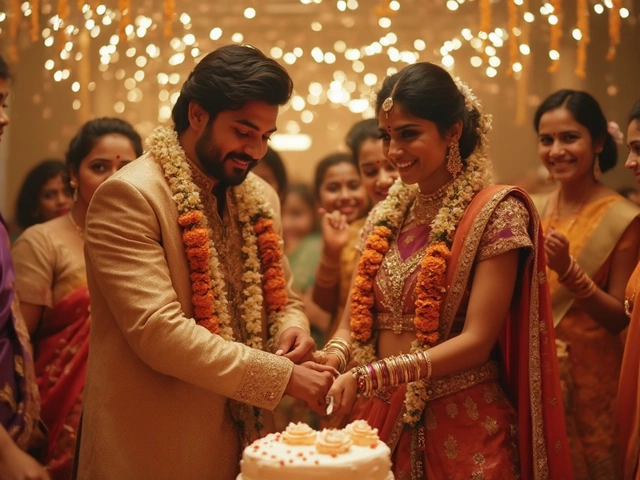
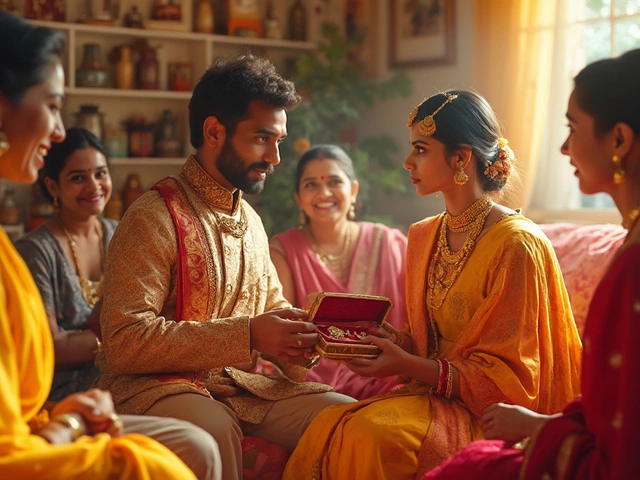

Comments
Post Comment